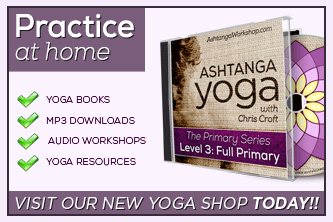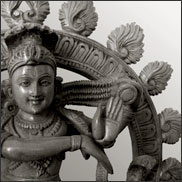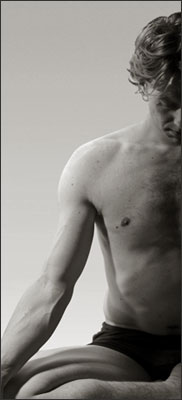The Myths of Ashtanga Yoga
Ashtanga Yoga is a beautiful, soft and feminine practice when the fundamentals of pranayama (breath control) are the primary focus of the practice.
There is very often a cloud of mystery and myth that surrounds the Ashtanga Vinyasa practice, instilling fears that will often keep people from ever trying this beautiful transformative tradition.
These myths are fostered by a combination of misunderstanding, fear and poor teaching
Here are some of the more common ones:
Myth #1:
Ashtanga Yoga is Power Yoga
I'll leave this one to the Guru...
This is a letter from Sri.K. Pattabhi Jois (the guru of Ashtanga Yoga) to Yoga Journal, Nov. 1995.
"I was disappointed to find that so many novice students have taken Ashtanga yoga and have turned it into a circus for their own fame and profit (Power Yoga, Jan/Feb 1995). The title "Power Yoga" itself degrades the depth, purpose and method of the yoga system that I received from my guru, Sri. T. Krishnamacharya. Power is the property of God. It is not something to be collected for one's ego. Partial yoga methods out of line with their internal purpose can build up the "six enemies" (desire, anger, greed, illusion, infatuation and envy) around the heart.
The full ashtanga system practiced with devotion leads to freedom within one's heart. The Yoga Sutra II.28 confirms this "Yogaanganusthanat asuddiksaye jnanadiptih avivekakhyateh", which means "practicing all the aspects of yoga destroys the impurities so that the light of knowledge and discrimination shines". It is unfortunate that students who have not yet matured in their own practice have changed the method and have cut out the essence of an ancient lineage to accommodate their own limitations.
The Ashtanga yoga system should never be confused with "power yoga" or any whimsical creation which goes against the tradition of the many types of yoga shastras (scriptures). It would be a shame to lose the precious jewel of libiration in the mud of ignorant body building”
Myth #2:
You have to be strong/fit/young/flexible to practice Ashtanga Yoga
Once again Sri.K. Pattabhi Jois said it best:
“Anyone can practice. Young man can practice. Old man can practice. Very old man can practice. Man who is sick, he can practice. Man who doesn't have strength can practice. Except lazy people; lazy people can't practice ashtanga yoga.”
Sometimes the way Ashtanga Yoga is taught (in the form of group led classes) can put people off and lead them to believe that Ashtanga Yoga is not for them.
When taught well all students, regardless of limitations, can benefit from this practice.
Fundamentally this practice is a breathing practice. So, if you can breath you can practice! However, to make it a bit more difficult you are asked to continue this breathing practice whilst the body is folded into more challenging positions, but it is still a breathing practice.
How much of the primary series you can ‘do’ or how many series you ‘complete’ is of NO relevance at all. How ‘good’ you are at each pose or what you look like whilst you practice has no importance to the practice either. Simply put it is the journey that we are interested in, not the destination.
Myth #3:
Ashtanga Yoga is hard
Ok well I guess it isn’t easy… but nothing really worthwhile is ever easy!!
Ashtanga is a progressive series and new poses are offered to the student as the student becomes ready. For some students the sun salutations might seem almost impossible, for others it will be poses later in the primary series that provide the difficulty.
All students encounter postures that are challenging, such is the nature of the system.
The limitations we inevitably encounter in our body are actually a mirror of the personal limitations and mental blocks that stop us being experiencing real freedom and personal contentment. As we move past these physical blocks (through practice) the Self unravels and becomes separated from the ego (what we think we are and are not).
Each student’s practice is completely individualised, unlike the typical pre-packaged 90-minute yoga class, an Ashtanga yoga practice grows with you as you grow.
Myth #4:
The Ashtanga Yoga sequence is too ‘rigid’
One myth about Ashtanga Yoga is that the structure of the series - there are 6 families of poses that you can progress through - is in some way rigid or limiting to the practitioner.
Each student begins with the Primary Series and, saving injury or illness, works his way through the sequence, pose by pose. This serves the purpose of providing structure and discipline to the initially scattered mind. Instead of being distracted the mind becomes focused and trained to follow a path, whether it wants to or not!
If true freedom and liberation from the binding nature of mind is ever to occur this initial training is important as it creates space (akasha) between what the mind wants to do and be (the ego), and what the body wants to do (intuition). This practice of separation (and then later re-integration) is an important step in any yoga practice.
Eventually over time the mind releases its attachments to the poses themselves and begins to surrender to the process occurring in the practice. But before this can occur there is often resistance from the mind to being tied into a system, yet it is the system that will eventually provide real freedom by creating a mind that is clear and still.
Given the option many yogis would only practice the poses they enjoy. However, in Ashtanga Yoga you don’t have a choice to just practice the poses you like (which are usually the ones you can do), you have to do them all, including the ones you hate!
Having a set sequence of poses means the student cannot avoid encountering themselves (and all their problems), in the guise of difficult poses. In a sequence where you don’t skip poses you are forced to face your limitations (and learn to overcome them) rather than avoid them.
Easy poses do not bring you closer to practicing yoga, challenging poses do because they require you to delve deeply into your physical, mental and emotional resources in order to master. This creates Tapas (heat) that burns through the illusory Self-image to reveal your real nature.
Very often though it is just at this point of friction - when things start becoming difficult - that people give in and stop practicing Ashtanga Yoga, but this is just when the yoga starts to become interesting. This inner resistance shows the practice is working. The resistance or desire to quit is in fact an invitation to personal freedom and spiritual liberation, but the practitioner has to find the courage and dedication to move into it rather than away from it.
So, rather than limiting, the sequence is actually the gateway to liberation.
Myth #5:
Ashtanga injures people
First of all, you are always at risk for injury. Whether you're a runner, biker, mountain climber, yogi, or just out walking your dog!!
The difference here is that if you were walking down the street and tripped over a curb, you would not blame the curb for your sprained ankle. Yet a yoga student gets hurt, and immediately blames the practice.
Ashtanga yoga does not injure people - but the way people practice Ashtanga yoga can.
The sequence is set up to give you the strength and flexibility for the next. The method requires you resolve one posture in your body before you get the next one. That way you approach new poses with a sufficient foundation of strength, balance or flexibility. This gentle progression is embodied in the Mysore Style teaching method.
During the first months practice, you will be bringing up and encountering all the imbalances in your body. So you may experience some pain or discomfort. The practice is designed to awaken deep sensations in the body, but not all pain is injury.
“What often happens to those who practice Ashtanga for the first time is that, after a month or so of regular practice, they begin to feel bodily pains they had never previously felt. Often, they believe they have hurt themselves through yoga and will either quit or practice less frequently ... often the practitioner has simply begun to awaken hurts or weaknesses that have always been present, but not aware of.” (Larry Shultz, It’s Yoga)





